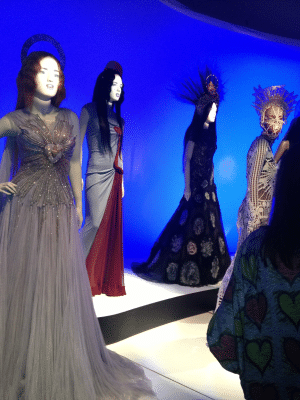Like any rebel who leaves his mark, Jean Paul Gaultier successfully capitalizes on the uncommon. He has dressed men in skirts, outfitted female models as rabbis, made the cone bra an indelible piece of pop culture, and as his traveling installation contends, crafted couture by infusing streetwear with high fashion and parading it down the runway.
In collaboration with the Montreal Museum of Fine Arts, Gaultier’s “From the Sidewalk to the Catwalk” debuted in June, 2011 and is currently housed at the Brooklyn Museum through February 23rd. With over 140 haute couture and ready-to-wear designs, the exhibit is divided into six sprawling sections – The Odyssey, The Boudoir, Skin Deep, Punk Cancan, Urban Jungle, and Metropolis – following a thematic approach versus a chronological one. There is an exhaustive timeline highlighting the designer’s prolific career and achievements, although this doesn’t require more than a few moments’ attention as anyone here is truly here for the clothes.
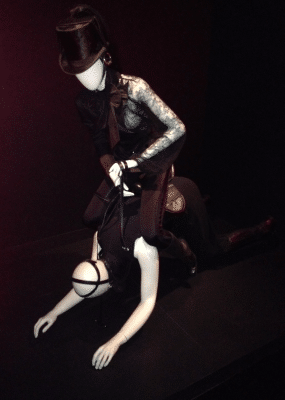
Viewers are first met by some of the recurring motifs in Gaultier’s work (Catholic headdresses, French maritime chic) presented on lifelike mannequins whose faces are animated via an audiovisual projection. Some of the models sing in unison and speak directly to the audience, while a few pose expectantly as though waiting for their pictures to be taken. A make believe Gaultier is present also, charismatically wavering between French and English and engaging onlookers with an overview of the exhibit.

Next up is The Boudoir, arguably the most intriguing section since we see firsthand how genius is spawned. Gaultier’s career started in 1970 when he was an assistant to Pierre Cardin, whose own genius for marketing a definitive and possibly irreverent idea must have rubbed off a little on JPG. We spy a frayed teddy bear displayed in a glass case with pieces of newspaper wrapped conically on its chest; after watching a French cabaret singer on television with his grandmother, Gaultier designed and executed his first bra at the age of five. On the opposite wall is an aptly included lesson in corsetry, which highlights his belief that rather than viewing it as an undergarment that is hidden and restricting, the corset should be sported as outerwear and deemed a “female suit of armor.”
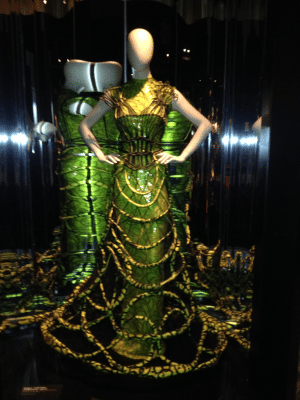
This offers a nice segue to the adjacent hall where you’ll most likely experience a few bottlenecks since it contains costumes, sketches, and photographs from Madonna’s game changing Blond Ambition tour. Gaultier’s relationship with Madonna has been an enduring one – he’s lent his talent to four of her tours over the past three decades. When inches away from looks that are seared into our minds from the last twenty-five years, it’s obvious their collaboration has lasted so long because they both have a knack for expertly using sex as an instrument of power. These are two iconoclasts who have held the same objective of educating the public by being as provocative as possible and luckily, they found one another. (Along with the Madonna outfits there are recognizable dresses and costumes that have been worn by Beyoncé, Carla Bruni, Catherine Deneuve and other celebs throughout the show.)
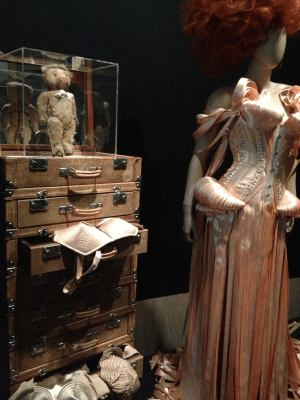
The designer has an equal fondness for non-convention when it comes to men; in 1984 he debuted his famed male skirt, perhaps an even greater milestone that offered a unique lesson in gender at a time when other designers were perhaps leaning toward the safe and staid. Likewise Gaultier sought to dispel the fashion world’s one dimensional perception of beauty by purposefully selecting models with shaved heads, pierced faces, and tattooed, plus-sized bodies, in turn flouting the runway’s unspoken rules. This theme is exhibited especially in the Punk section of the show, where mohawks and tartan clad models are met by a backdrop of graffiti that wouldn’t appear out of place on a 1980’s New York City subway car.
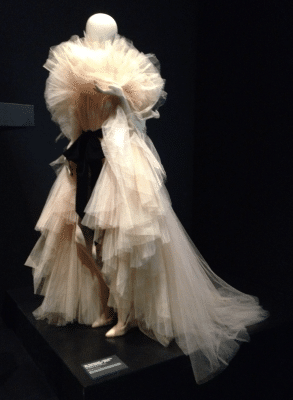
It’s fair to say that Gaultier has always embraced the punk counterculture and in certain respects is a rock star in his own right. When we see his work shot by the likes of Warhol, Mario Testino and David LaChapelle, we realize that his designs have fostered the idea of celebrity and these artists have advanced it through their paintings and photographs. Most of Gaultier’s creations in the exhibit would never be seen on the person on the street and perhaps that’s the point – these are pieces that should be displayed, considered, and admired as works of art.
[alert type=white]
Brooklyn Museum
200 Eastern Parkway
Brooklyn, NY 11238-6052
718.638.5000
Additional Information:
*Closes February 23rd, 2014 (heading to London’s Barbican Gallery)
Museum Hours:
Monday, Tuesday – Closed
Wednesday – 11am-6pm
Thursday – 11am-10pm
Friday-Sunday – 11am-6pm
First Saturday of the month – 11am-11pm
Admission: $15
[/alert]

